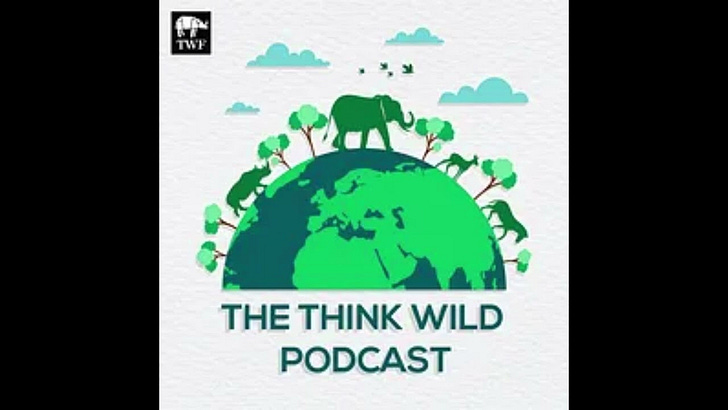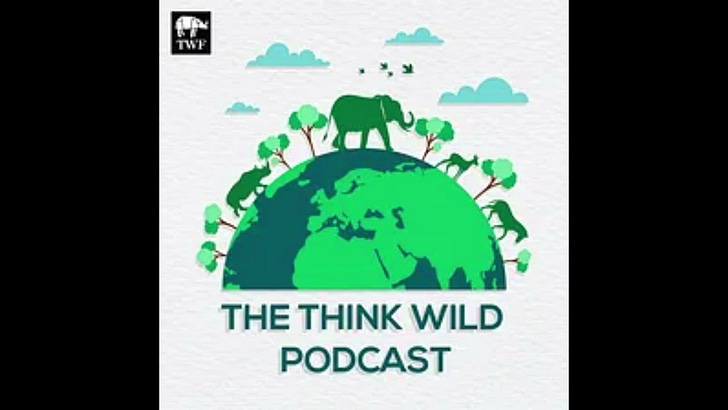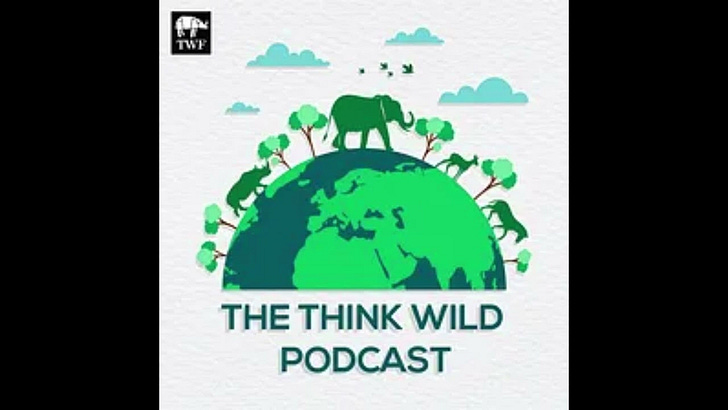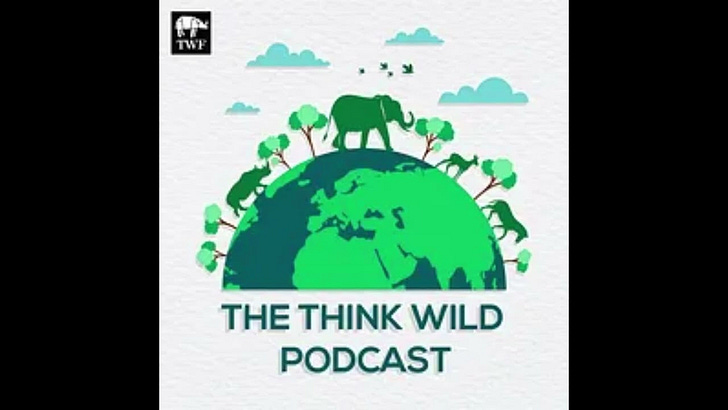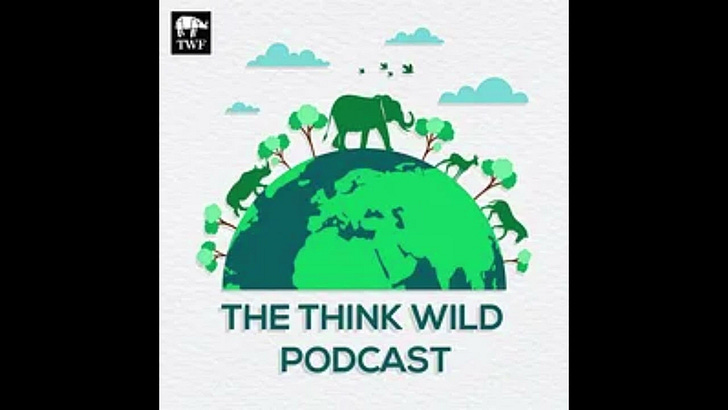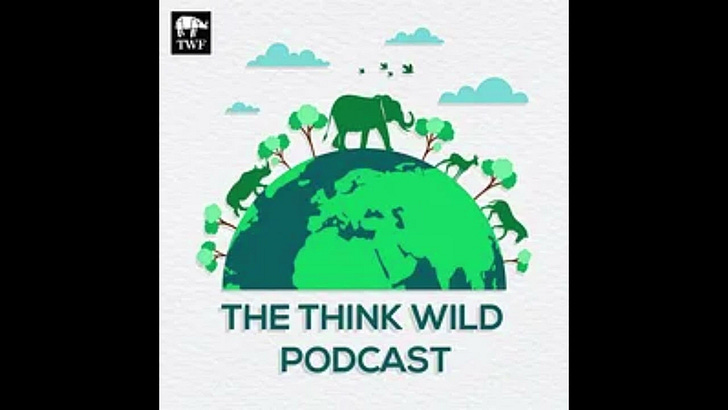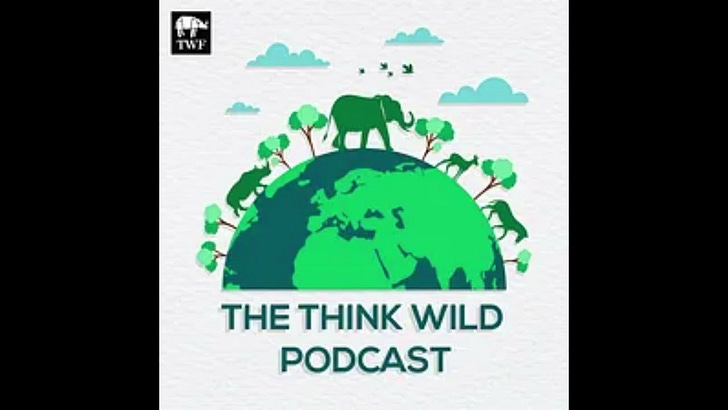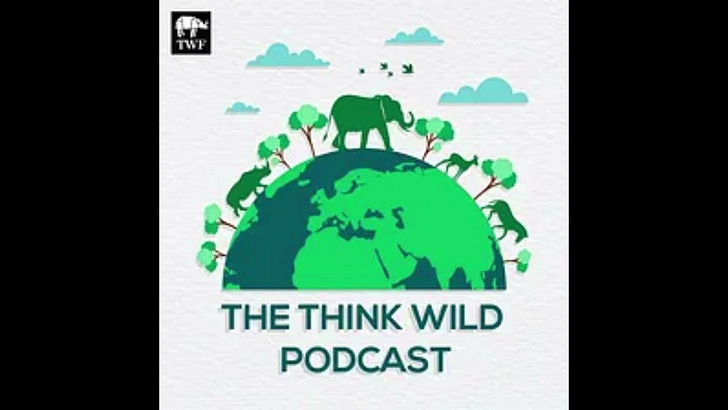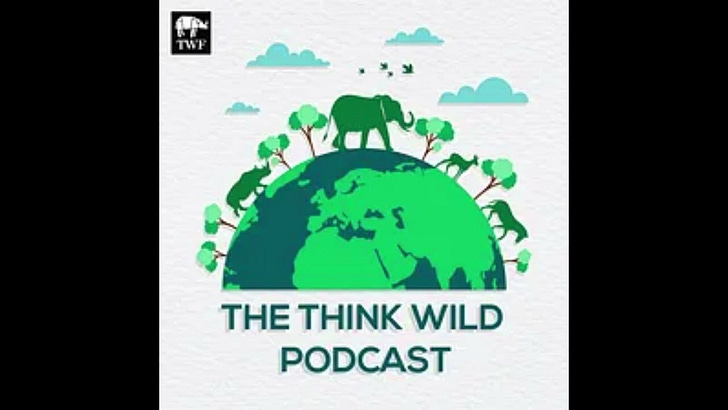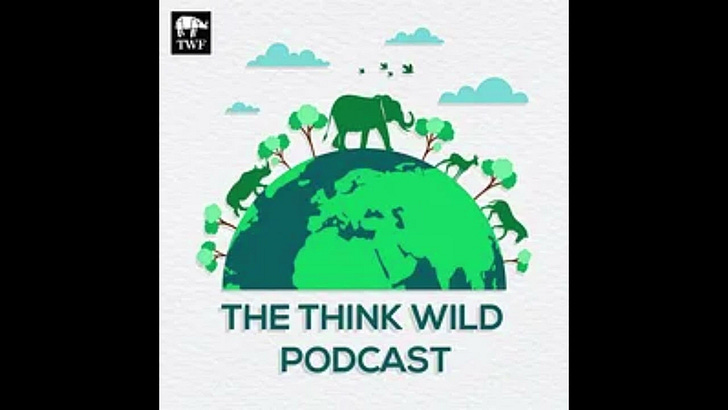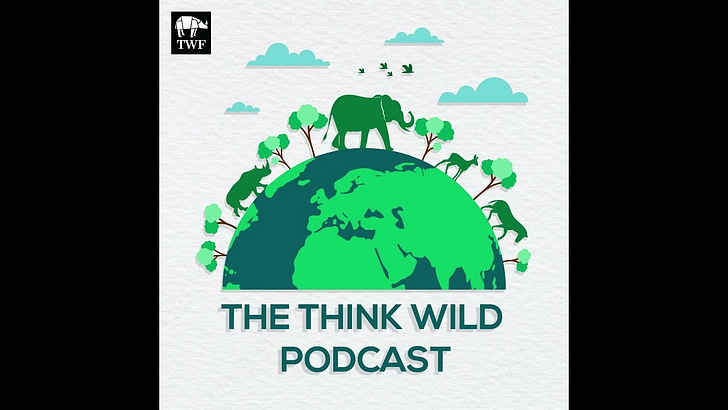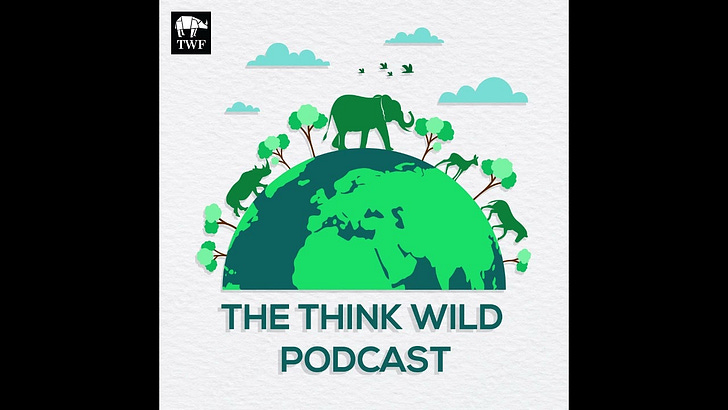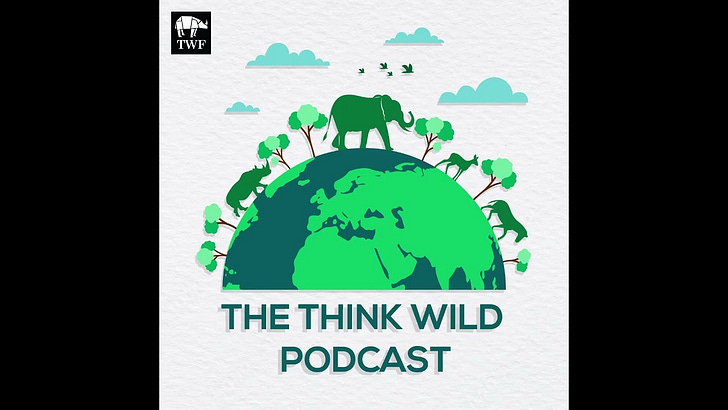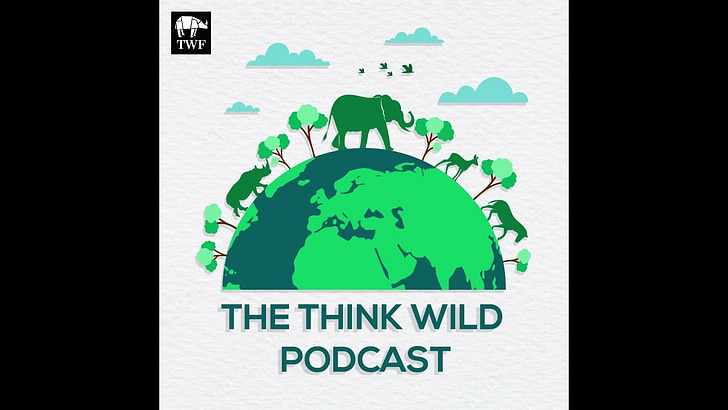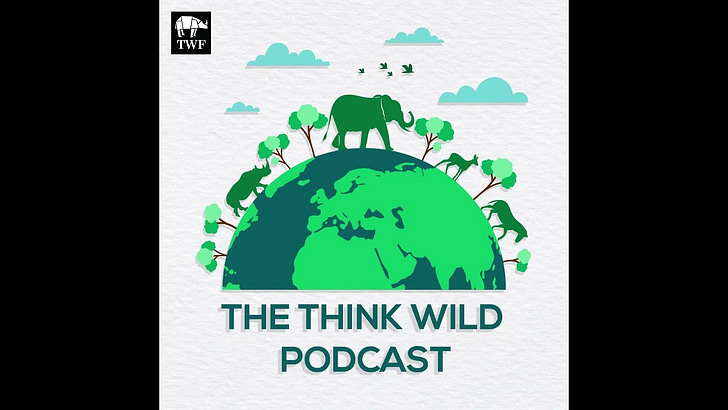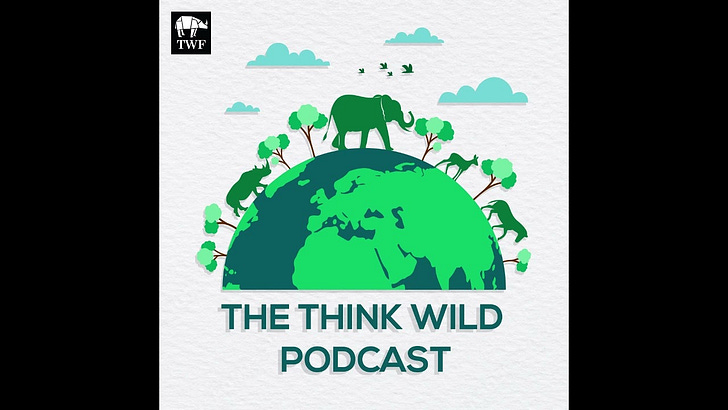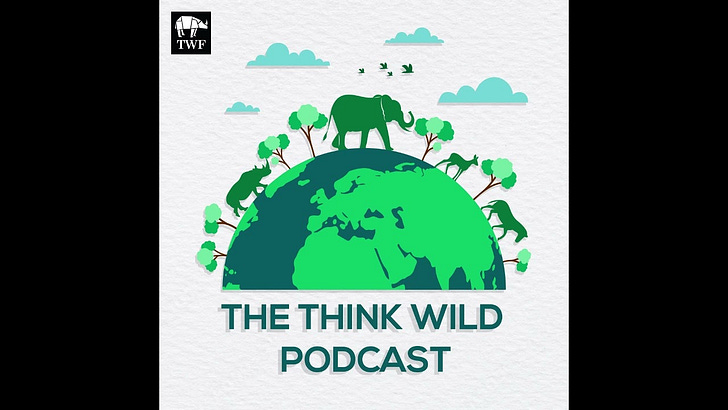Discover The Think Wildlife Podcast
The Think Wildlife Podcast

The Think Wildlife Podcast
Author: The Think Wildlife Podcast
Subscribed: 17Played: 159Subscribe
Share
© Anish Banerjee
Description
Every Monday, join our hosts, Anish Banerjee, as he speaks with renowned conservationists from around the world, dissecting some of the most pressing and intricate challenges threatening wildlife.
anishbanerjee.substack.com
anishbanerjee.substack.com
152 Episodes
Reverse
India’s coastal waters hold immense promise—and growing peril. In this episode of the Think Wildlife Podcast, host Anish Banerjee speaks with Oishinee Chakraborty from the Kuddle Life Foundation, a young organization redefining marine conservation in Pondicherry through science, community collaboration, and artificial reefs.Oishinee introduces listeners to the Foundation’s origins—founded in 2020 by Punit Dhandhania and Hans Dhandhania, who transformed a small circle of ocean enthusiasts into a leading grassroots force for marine ecology and biodiversity conservation. With limited institutions working on ocean protection in southern India, Kuddle Life fills a critical gap by creating local, science-driven projects that link marine ecosystems, coastal livelihoods, and sustainable development.At the heart of their work lies the artificial reef program—a groundbreaking effort to restore degraded marine ecosystems and revive marine biodiversity. Oishinee explains that space is the ocean’s most limiting factor, and artificial reefs—built using eco-friendly materials like concrete and steel—mimic the natural hard surfaces that corals, sponges, and fish larvae need to attach, grow, and form thriving underwater communities. These structures replicate some functions of natural coral reefs, acting as catalysts for marine biodiversity management and ecosystem recovery.The process of building an artificial reef begins with community engagement. Fisherfolk are invited to share local ecological knowledge and help identify suitable sites for reef deployment. Scientists then assess seabed topography, water quality, and existing biodiversity before designing reef modules—each over 500 kg and a meter tall. Local divers and fishermen help deploy the structures less than five kilometers offshore, making the effort both participatory and empowering.Monitoring continues for years, as reefs mature and attract a diversity of marine wildlife. In Pondicherry, Kuddle Life has recorded remarkable results: a 20% rise in dissolved oxygen, increased chlorophyll levels, and nearly a fourfold growth in fish abundance. For local fishers, incomes have doubled—from ₹5,000 to ₹10,000 per day—while fuel costs have halved because fishing now occurs closer to shore. These outcomes highlight how marine biodiversity conservation can drive both ecological and economic resilience.Globally, artificial reefs have become vital tools for restoring marine ecosystems damaged by climate change, overfishing, and pollution. Yet, as Oishinee reminds us, nothing can replace natural coral reefs. Artificial structures can only supplement lost habitat, not substitute for nature’s complexity. Still, by reviving degraded areas and promoting sustainable fishing, these reefs help maintain ocean productivity in a warming world.Beyond reef restoration, the Kuddle Life Foundation runs educational and research programs across India. Through marine litter surveys, bycatch reduction initiatives, dive training, and youth internships, the foundation is building a generation of ocean stewards. Its unique for-profit dive center reinvests earnings into conservation, while volunteers support marine ecology projects both underwater and onshore—from data analysis to biodiversity monitoring.Oishinee also discusses the challenges of sustaining NGO work in India—funding barriers, bureaucratic delays, and the slow pace of conservation impact. Yet, she finds hope in the growing public interest in marine biodiversity, particularly when students and non-biologists approach her asking how they can help. That curiosity, she believes, is the first step toward lasting ocean change.This episode reveals how grassroots innovation, science, and compassion are reshaping marine biodiversity hotspots along India’s coast—proving that ocean recovery begins not just beneath the waves, but within communities themselves.#artificialreefs #marineecology #marineecosystems #marinebiodiversity #marineconservation #marinewildlife #marinebiodiversityhotspot #marinebiodiversityconservation #biodiversityconservation #biodiversity #biodiversitymanagementAbout the HostAnish Banerjee is an early career ecologist, with a MSc in Ecology, Evolution and Conservation from Imperial College London. He is the founder of Think Wildlife Foundation and a biodiversity policy analyst at Legal Atlas. He is also the author of the following field guides:Field Guide to the Common Wildlife of India: https://amzn.in/d/2TnNvSEField Guide to the Mammals of Singapore: https://amzn.in/d/gcbq8VG Get full access to The Think Wildlife Podcast at anishbanerjee.substack.com/subscribe
Nepal is home to some of the world’s most iconic wildlife — from tigers, rhinos, and elephants to lesser-known species like pangolins and medicinal orchids. Yet behind its breathtaking biodiversity lies a complex struggle against wildlife poaching, illegal wildlife trade, and habitat loss. In this episode of the Think Wildlife Podcast, we speak with Kumar Paudel, founder and director of Greenhood Nepal, one of the nation’s leading conservation organizations working to combat wildlife crime and promote community conservation across the Himalayas.Kumar shares his inspiring journey from a childhood in the mountains of Nepal to leading national efforts in biodiversity conservation. Through his work with Greenhood Nepal, he has helped transform the country’s conservation landscape — from early advocacy against poaching and corruption to the establishment of community-based monitoring networks and policy reform. Under his leadership, Nepal became the first nation to achieve zero poaching of rhinos, elephants, and tigers, an achievement rooted in strong enforcement, military protection, and deep community engagement.The conversation delves into the evolution of Nepal’s conservation success. Kumar discusses how community intelligence and local anti-poaching networks have become vital in protecting wildlife across national parks and buffer zones. Yet, he warns that while attention often centers on charismatic megafauna like tigers and rhinos, smaller and lesser-known species such as pangolins, tortoises, and orchids face rising threats from illegal wildlife trade and unsustainable harvesting.Greenhood Nepal’s work along the China–Nepal border provides critical insights into cross-border wildlife trade networks, revealing the motivations behind trafficking and empowering enforcement agencies through training, data sharing, and behavioral change campaigns. Kumar also highlights their pioneering research on orchid conservation, mapping over 500 native species — including more than 100 medicinally important orchids — and developing sustainable management plans that align with CITES compliance.The discussion also explores pangolin conservation, where Greenhood has led community outreach, identified priority habitats, and hosted Nepal’s first Pangolin Conservation Roundtable, catalyzing national policy action. Kumar explains how the team’s on-ground efforts — from habitat restoration to education and enforcement — have shaped the future of biodiversity management in Nepal.Beyond enforcement, Kumar reflects on the importance of compassion and understanding. His most memorable conservation experience came from visiting prisons and speaking with wildlife offenders, gaining firsthand insights into the socio-economic pressures that drive poaching and wildlife trade. His reflections underscore that sustainable conservation depends on addressing poverty, awareness, and opportunity — not just punishment.We also revisit Nepal’s remarkable success in tiger conservation, where populations have nearly tripled between 2010 and 2022, and discuss emerging challenges such as human–wildlife conflict. As Nepal continues to balance conservation and development, Kumar calls for stronger investment in coexistence strategies, habitat restoration, and community-led solutions.This episode offers an in-depth look at the intertwined issues of wildlife crime, community conservation, and biodiversity preservation in one of the world’s richest ecological regions. Tune in to learn how Nepal’s story of resilience, innovation, and collaboration continues to inspire the global conservation movement.About the HostAnish Banerjee is an early career ecologist, with a MSc in Ecology, Evolution and Conservation from Imperial College London. He is the founder of Think Wildlife Foundation and a biodiversity policy analyst at Legal Atlas. He is also the author of the following field guides:Field Guide to the Common Wildlife of India: https://amzn.in/d/2TnNvSEField Guide to the Mammals of Singapore: https://amzn.in/d/gcbq8VG#Nepal #tigers #elephants #rhino #wildlife #wildlifeconservation #wildlifecrime #poaching #wildlifepoaching #hunting #wildlifetrade #illegalwildlifetrade #conservation #biodiversity #biodiversityofNepal #biodiversityconservation #biodiversitymanagement #orchids #orchidconservation #pangolins #communityconservation #communityengagement5 Get full access to The Think Wildlife Podcast at anishbanerjee.substack.com/subscribe
As the global biodiversity crisis intensifies, the race is on to design financial systems that protect nature rather than destroy it. In this episode of the Think Wildlife Podcast, Dr. Samuel Sinclair, co-founder of Biodiversify, unpacks the evolution of biodiversity credits, the limitations of the current biodiversity credit market, and the urgent need for credible biodiversity conservation finance. Based in the UK, Biodiversify works with global corporations, governments, and NGOs to make businesses truly nature positive—moving beyond carbon neutrality to measurable biodiversity net gain.Dr. Sinclair traces his path from fieldwork in Tanzania and anti-poaching initiatives with the African Wildlife Foundation to pioneering frameworks that help major brands like Kering, Primark, Tetra Pak, and Amazon integrate biodiversity management into corporate strategy. He explains why biodiversity credits have not scaled like carbon credits, emphasizing the lack of standardized metrics, corporate incentives, and clear biodiversity credit standards. For credits to be effective, he argues, they must directly address business risks—such as threats to commodity supply chains—and become tied to real ecological outcomes.The discussion delves into the emerging biodiversity finance landscape: from the EU Corporate Sustainability Reporting Directive (CSRD) and Taskforce on Nature-Related Financial Disclosures (TNFD) to Science-Based Targets for Nature (SBTN). These frameworks are transforming how companies assess, report, and invest in biodiversity. Sinclair explains how Biodiversify helps clients navigate these systems, ensuring their corporate biodiversity credits and biodiversity net gain commitments align with global best practices.We explore the critical difference between nature credits and carbon credits, why biodiversity cannot be reduced to a single global metric, and how new biodiversity credit regulations could create markets that reward genuine ecological restoration. Sinclair also reflects on his field experiences across Africa, where conservation taught him that protecting ecosystems is as much about people as wildlife.This episode is a must-listen for conservation professionals, sustainability officers, and anyone curious about investing in biodiversity as the next frontier in environmental finance. Learn how corporate action, regulatory innovation, and on-the-ground conservation can merge to halt biodiversity loss and deliver a nature-positive future.About the HostAnish Banerjee is an early career ecologist, with a MSc in Ecology, Evolution and Conservation from Imperial College London. He is the founder of Think Wildlife Foundation and a biodiversity policy analyst at Legal Atlas. He is also the author of the following field guides:Field Guide to the Common Wildlife of India: https://amzn.in/d/2TnNvSEField Guide to the Mammals of Singapore: https://amzn.in/d/gcbq8VG#biodiversity #biodiversitycredits #biodiversitycreditmarket #biodiversityconservation #biodiversitymanagement #biodiversitypreservation #biodiversityhotspot #biodiversitynetgain #naturepositive #biodiversitycrisis #biodiversitymarkets #biodiversityfinance #investinginbiodiversity #biodiversityconservationfinance #biodiversitycreditstandards #corporatebiodiversitycredits #biodiversitycreditregulations #differencebetweennaturecreditsandcarboncredits Get full access to The Think Wildlife Podcast at anishbanerjee.substack.com/subscribe
In this episode of the Think Wildlife Podcast, we travel to the frozen frontiers of the Arctic to uncover one of conservation’s most inspiring success stories — the revival of the Arctic fox in Svalbard and Fennoscandia. Host Anish Banerjee is joined by Nina Elisabeth Eide from the Norwegian Institute for Nature Research (NINA), who shares her remarkable two-decade journey studying and protecting wild canids in one of the world’s harshest environments.Once reduced to barely 40–60 individuals, the Arctic fox population in Scandinavia teetered on the edge of extinction due to overhunting, climate change, and competition with red foxes. Through dedicated efforts in wild canid conservation, the population has rebounded more than tenfold to nearly 600 foxes — a triumph made possible by scientific research, adaptive management, and international cooperation.Nina describes how her PhD work in Svalbard explored the ecology and spatial behaviour of Arctic foxes, revealing how these resilient predators adapt to shifting prey availability across coastal and inland tundra. She explains their extraordinary biological adaptations — from thick fur and fat reserves to metabolic slowdown — that allow them to endure months of Arctic winter without freezing even at –40°C.The discussion delves deep into the innovative conservation measures behind the Arctic fox’s recovery:Supplemental feeding stations strategically placed near den sites to enhance pup survival and reproduction.Red fox control programmes that limit competition in critical Arctic habitats.A successful captive-breeding and reintroduction programme, which has released over 460 foxes into the wild, boosting eight distinct sub-populations across Norway, Sweden, and Finland.Long-term genetic monitoring, collecting nearly 800 DNA samples annually to track individuals, maintain genetic diversity, and assess the success of reintroduced foxes.Beyond the science, Nina reflects on the emotional highs of conservation — from the joy of releasing foxes into the wild to the collective sense of achievement when a once-critically endangered species begins to recover. Yet, she warns that ongoing threats like climate change, habitat fragmentation, and red fox expansion still pose challenges to the long-term survival of Arctic biodiversity.This episode offers a rare glimpse into the perseverance and ingenuity that define modern wildlife conservation. It highlights how collaboration between scientists, governments, and local communities can restore fragile ecosystems and preserve the delicate balance of Arctic biodiversity.Join us to learn about the ecology, behaviour, and conservation of one of the Arctic’s most charismatic species — and what its recovery means for the broader effort to safeguard biodiversity hotspots under a changing climate.Whether you are a wildlife enthusiast, conservation biologist, or simply someone inspired by stories of nature’s resilience, this conversation captures the essence of why protecting wild canids like the Arctic fox is vital for the future of our planet’s biodiversity and nature.About the HostAnish Banerjee is an early career ecologist, with a MSc in Ecology, Evolution and Conservation from Imperial College London. He is the founder of Think Wildlife Foundation and a biodiversity policy analyst at Legal Atlas. He is also the author of the following field guides:Field Guide to the Common Wildlife of India: https://amzn.in/d/2TnNvSEField Guide to the Mammals of Singapore: https://amzn.in/d/gcbq8VG#ThinkWildlifePodcast #ArcticFoxes #WildCanids #FoxConservation #WildCanidConservation #SvalbardBiodiversity #ArcticBiodiversity #ArcticBiodiversityConservation #Biodiversity #BiodiversityConservation #BiodiversityHotspot #Ecology #Wildlife #Nature Get full access to The Think Wildlife Podcast at anishbanerjee.substack.com/subscribe
The African savannas once echoed with herds of graceful antelopes—species perfectly adapted to life in some of the harshest landscapes on Earth. Among them, the Beisa oryx stands out as a symbol of resilience, yet today it faces growing threats from habitat loss, poaching, and human expansion. In this episode of the Think Wildlife Podcast, we explore the inspiring story of oryx conservation and rewilding efforts that are giving this striking desert antelope a second chance. Joining us on this episode is the Save Beissa Oryx Community Trust.Our guest shares insights into the ongoing work to restore beisa oryx populations across East Africa, particularly in Kenya, Ethiopia, and northern Tanzania, where community-led initiatives are transforming degraded landscapes into thriving habitats. Once driven to near-extinction in many parts of its range, the beisa oryx is now a beacon of what community conservation and science-based rewilding can achieve when local people, governments, and conservation organizations work together.The discussion delves into how rewilding oryxs serves as a powerful tool for biodiversity conservation, helping to restore the ecological balance of savanna ecosystems. By reintroducing oryxes into protected landscapes, conservationists are not only reviving a species but also revitalizing entire food webs that depend on large herbivores. The Beisa oryx, with its striking black-and-white facial markings and long, straight horns, plays a key role in shaping grassland dynamics, dispersing seeds, and maintaining healthy vegetation.Listeners will also learn how community conservation models are making this success possible. From the conservancies of northern Kenya to collaborative management zones across the Horn of Africa, local communities are leading the charge—monitoring wildlife, reducing poaching, and promoting coexistence with antelopes and other large mammals. By linking livelihood benefits to conservation outcomes, these programs are redefining what it means to protect wildlife in the 21st century.The episode also explores how rewilding efforts for the beisa oryx tie into larger continental and global biodiversity goals. As African nations implement ecosystem restoration targets under the UN Decade on Ecosystem Restoration, projects like oryx rewilding highlight the power of combining indigenous knowledge, modern ecological science, and grassroots participation. Beyond simply bringing back a species, rewilding aims to rebuild functional ecosystems where antelope species like the oryx can once again roam freely across their historical range.In this thought-provoking conversation, we discuss the challenges ahead: securing enough land for expanding populations, mitigating conflicts with livestock herders, and addressing the pressures of climate change. Yet, amid these challenges lies hope—the sight of newly reintroduced beisa oryxes galloping across restored savannas is proof that conservation can turn back the clock of extinction.Ultimately, this episode is a celebration of resilience—of the oryx, of the communities that protect it, and of the collective belief that conservation is not just about saving wildlife, but about sustaining the ecosystems and cultures that depend on them.Join us as we journey into the heart of oryx conservation, learning how science, storytelling, and community action are uniting to rewild Africa’s landscapes. Discover how each reintroduced antelope represents a step toward restoring the continent’s wild beauty—and a vision of coexistence where people and wildlife thrive together.About the HostAnish Banerjee is an early career ecologist, with a MSc in Ecology, Evolution and Conservation from Imperial College London. He is the founder of Think Wildlife Foundation and a biodiversity policy analyst at Legal Atlas. He is also the author of the following field guides:Field Guide to the Common Wildlife of India: https://amzn.in/d/2TnNvSEField Guide to the Mammals of Singapore: https://amzn.in/d/gcbq8VG#antelope #oryx #oryxconservation #rewilding #rewildingoryxs #beisaoryx #beisaoryxrewilding #beisaoryxconservation #communityconservation #biodiversityconservation #conservation #wildlifeconservation #africanwildlife #ecosystemrestoration #rewildingafrica Get full access to The Think Wildlife Podcast at anishbanerjee.substack.com/subscribe
In this episode of the Think Wildlife Podcast, we explore one of India’s most unique and little-known primates — the slender loris, a small nocturnal primate that thrives in the tree canopies of southern India and Sri Lanka. Joining us is Professor Kaberi Kar Gupta, visiting scientist at the Indian Institute of Science and founder of the Urban Slender Loris Project, who shares her decades-long journey from studying forest ecology to pioneering urban ecology and urban wildlife conservation in Bengaluru.Professor Gupta recounts her early fascination with nature, from growing up in the green outskirts of Kolkata to working in the forests of Tamil Nadu. Her research on primate ecology began in the forests of Kalakad–Mundanthurai Tiger Reserve, where she studied slender loris behavior, home ranges, and mating systems, uncovering intricate details about their ecology and survival strategies. Over time, she turned her attention to how these primates adapt to city environments — leading to the creation of the Urban Slender Loris Project in Bengaluru, a groundbreaking citizen science initiative that brings together researchers, local communities, and volunteers to monitor and conserve these elusive nocturnal primates.The discussion dives into the urgent need for urban biodiversity conservation and biodiversity management in rapidly growing cities. Professor Gupta highlights how urban green spaces — once thriving with life — are vanishing under expanding infrastructure. Through the project, community members were trained to conduct night surveys, map loris habitats, and identify key trees and corridors that sustain these animals. Their collective effort revealed both the resilience of urban biodiversity and the fragility of these ecosystems under urban expansion.We also discuss the results of a recent study on public attitudes towards slender lorises in Bengaluru. The findings show that while urban residents often appreciate local wildlife, awareness about species like the slender loris remains limited. Cultural myths, once linked to black magic, are fading, but habitat destruction and lack of awareness continue to pose serious threats.Professor Gupta’s reflections go beyond the science — touching on her personal experiences in wild Karnataka, encounters with wildlife traders during early conservation work, and moments of awe witnessing tigers and lorises in their natural habitats. Her message is clear: connecting people to nature within cities is essential for the future of conservation. As more people become urban dwellers, initiatives like the Urban Slender Loris Project show how science, community participation, and empathy for wildlife can coexist in even the most crowded environments.Whether you’re a student of urban biology, a wildlife enthusiast, or a conservationist, this conversation offers a profound look into how small nocturnal primates like the slender loris can inspire a new model of biodiversity preservation in the heart of India’s tech capital.Tune in to discover the story of the slender loris — the hidden primate of Bengaluru — and how local communities are shaping the future of urban wildlife conservation.About the HostAnish Banerjee is an early career ecologist, with a MSc in Ecology, Evolution and Conservation from Imperial College London. He is the founder of Think Wildlife Foundation and a biodiversity policy analyst at Legal Atlas. He is also the author of the following field guides:Field Guide to the Common Wildlife of India: https://amzn.in/d/2TnNvSEField Guide to the Mammals of Singapore: https://amzn.in/d/gcbq8VG#urbanecology #urbanbiology #urbanbiodiversity #urbanwildlife #urbanwildlifeconservation #urbanbiodiversityconservation #biodiversity #biodiversityconservation #biodiversitymanagement #biodiversitypreservation #slenderloris #loris #slenderlorisconservation #slenderlorisecology #primateecology #primates #primateconservation #wildkarnataka #conservation Get full access to The Think Wildlife Podcast at anishbanerjee.substack.com/subscribe
High in the misty forests of North Bengal and Northeast India, a quiet conservation movement is unfolding around one of the world’s most charismatic yet misunderstood mammals — the red panda. In this episode of the Think Wildlife Podcast, host Anish Banerjee speaks with young conservationist Aamir Khan Sohel, whose pioneering work bridges red panda conservation breeding, community-led conservation, and the power of science communication through his initiative, Translating Conservation.Aamir’s journey began unconventionally — from engineering to ecology — driven by a desire to use technology to aid conservation. He recounts how he was drawn to the red panda, a species native to the Eastern Himalayas and an important indicator of ecosystem health. Through his project in Darjeeling, he studies red panda behavior, welfare, and reintroduction success within India’s first red panda conservation breeding program, initiated at the Darjeeling Zoo in collaboration with the Government of India and international partners.The episode delves into the fascinating world of red panda conservation breeding — how scientists train captive individuals to survive in the wild, teaching them essential behaviors like foraging and predator avoidance before their release into protected areas such as Singalila and Neora Valley National Parks. Aamir explains the scientific and logistical hurdles in bridging captive and wild populations, the reasons behind long gaps between reintroductions, and how welfare-based behavioral studies are improving the outcomes of conservation breeding programs.Beyond the lab and breeding centers, the conversation explores the human dimensions of biodiversity conservation. Aamir’s community-led conservation model empowers local residents to become long-term wildlife monitors by combining traditional knowledge with scientific training. These community guardians help track red panda populations across the mountainous terrain, offering valuable insights into how climate change, tourism, and habitat degradation affect this elusive species and the broader Himalayan biodiversity hotspot.He highlights the major threats facing red pandas — including biodiversity loss, habitat fragmentation, bamboo depletion, and the growing menace of feral dogs in high-altitude forests. Climate warming is altering microhabitats and pushing red pandas higher up the mountains, making long-term monitoring even more essential for conservation success.Aamir also introduces Translating Conservation, his innovative science outreach platform that breaks down complex ecological research into accessible content — from simplified articles to comics and animations — ensuring conservation knowledge reaches local communities and the general public. For Aamir, translating conservation is not just about communication but about inclusion — enabling everyone to participate in protecting India’s rich biodiversity.From funding challenges to field hardships, his story reflects the persistence and creativity required to conserve one of the most threatened species of the Himalayas. His upcoming research, supported by the University of Adelaide, aims to expand this model of collaborative, community-based conservation across North Bengal and the broader Northeast India landscape.This episode offers a heartfelt and deeply insightful look at how science, empathy, and local stewardship come together to safeguard the red panda — a symbol of balance in fragile mountain ecosystems.About the HostAnish Banerjee is an early career ecologist, with a MSc in Ecology, Evolution and Conservation from Imperial College London. He is the founder of Think Wildlife Foundation and a biodiversity policy analyst at Legal Atlas. He is also the author of the following field guides:Field Guide to the Common Wildlife of India: https://amzn.in/d/2TnNvSEField Guide to the Mammals of Singapore: https://amzn.in/d/gcbq8VG#redpanda #redpandaconservation #redpandaconservationbreeding #northbengal #northeastindia #translatingconservation #biodiversity #biodiversityconservation #biodiversityhotspot #biodiversityloss Get full access to The Think Wildlife Podcast at anishbanerjee.substack.com/subscribe
In this episode of the Think Wildlife Podcast, we speak with Ishan Shanavas — a nature photographer, author, and founder of EcoInspire, an environmental education initiative that has already reached over 20,000 students across 70 schools in five Indian states. Through engaging storytelling, dynamic school sessions, and vivid wildlife photography, Ishan is helping shape how young people understand and appreciate biodiversity and the natural world.Growing up on road trips through the Bandipur Tiger Reserve and studying at a school nestled in the forests of Andhra Pradesh, Ishan’s early experiences surrounded by wildlife sparked his lifelong passion for conservation. His bestselling book The Lighter Wilder Things became the foundation for Mission EcoInspire, a project dedicated to promoting biodiversity conservation and environmental awareness among students. Realizing that online conservation messages often remain confined to a small, like-minded audience, Ishan set out to bring these conversations directly into classrooms. His approach emphasizes the need for early biodiversity education and environmental education as essential tools to nurture empathy, understanding, and curiosity about wildlife and ecosystems.In the episode, Ishan discusses the origins of his conservation journey and the goals of EcoInspire. He reflects on the power of face-to-face interaction in conservation outreach and conservation education, sharing how simple, accessible communication can inspire students to take interest in biodiversity management and wildlife conservation. He explains how schools across cities like Bangalore, Mysore, Trivandrum, Chennai, Hyderabad, and Gulbarga have welcomed his sessions, with both teachers and students showing overwhelming enthusiasm. The program’s success demonstrates that hands-on environmental engagement remains one of the most effective ways to build lasting connections with nature.Ishan also explores the role of social media in spreading environmental awareness. He highlights how platforms can amplify meaningful conservation stories when used responsibly, but also cautions against misinformation and sensationalism. He shares valuable advice for conservationists aiming to improve their communication — simplifying complex topics, avoiding technical jargon, and using creativity, humor, and visual storytelling to reach wider audiences. He mentions innovative communicators like Rohan Chakravarti (Green Humor) and the Dhole Project in Kerala, both of whom effectively use art and media to connect people with Indian biodiversity.The discussion underscores that conservation is not just about protecting species but about building emotional and cultural bridges between people and nature. Ishan’s message is clear: the success of wildlife conservation and biodiversity management depends on reaching beyond scientific circles and inspiring collective action. Through EcoInspire, he is demonstrating how passionate individuals can make conservation accessible, engaging, and relevant to younger generations.By sharing his journey, Ishan shows that the heart of biodiversity conservation lies in empathy, education, and communication. Whether through a classroom presentation, a book, or a digital post, his work reminds us that protecting India’s natural heritage requires inspiring the minds and hearts of those who will shape its future.Tune in to learn how one individual’s commitment to conservation outreach and environmental education is inspiring thousands of young Indians to rediscover their connection with wildlife and work toward a sustainable future.About the HostAnish Banerjee is an early career ecologist, with a MSc in Ecology, Evolution and Conservation from Imperial College London. He is the founder of Think Wildlife Foundation and a biodiversity policy analyst at Legal Atlas. He is also the author of the following field guides:Field Guide to the Common Wildlife of India: https://amzn.in/d/2TnNvSEField Guide to the Mammals of Singapore: https://amzn.in/d/gcbq8VG Get full access to The Think Wildlife Podcast at anishbanerjee.substack.com/subscribe
In this episode of the Think Wildlife Podcast, we are joined by Etelle Higonnet, founder of Coffee Watch, a nonprofit watchdog organization dedicated to the proposition that we should make the world a better place with each cup of coffee. We uncover the hidden environmental and social costs of the global coffee industry — from deforestation and ecosystem degradation to human rights violations in coffee plantations in tropical landscapes around the world, with a focus on the Western Ghats biodiversity hotspot!Once covered in dense tropical forests, the Western Ghats are now dominated by sprawling coffee plantations and monoculture plantations that have drastically altered the landscape. Our guest explores how the expansion of coffee production — driven by global demand — has replaced rich forest ecosystems with uniform monocultures, stripping away the region’s ecological resilience. The shift from traditional shade-grown systems to sun-grown monocultures has disrupted soil health, eliminated natural canopy cover, and endangered pollinators, birds, and mammals that once thrived in these biodiversity-rich ecosystems.We dive deep into the link between coffee plantations and human–elephant conflict. As forest corridors shrink and elephants lose access to their migratory routes, they are forced into human settlements, resulting in tragic encounters that claim both human and animal lives. These conflicts reveal how unsustainable land use, habitat fragmentation, and poor biodiversity management intensify tensions between people and wildlife across the Western Ghats.The conversation also exposes the human dimension of the coffee industry — from exploitative labor practices to widespread human rights abuses. Behind the global demand for coffee lies a system where workers, many from marginalized communities, face poor wages, long working hours, and limited access to healthcare and education. These persistent human rights violations highlight how plantation economies, often celebrated for sustainability branding, continue to mask deep social inequities.Despite these challenges, the episode highlights pathways toward hope and reform through agroforestry and sustainable farming models. Traditional shade-grown coffee — where native trees coexist with coffee shrubs — demonstrates that economic production and biodiversity preservation can go hand in hand. Agroforestry practices support soil fertility, regulate microclimates, and restore ecological corridors, offering a viable alternative to monoculture plantations. They also provide co-benefits for farmers by diversifying income sources and improving resilience to climate change.Our guest calls for systemic change within global coffee supply chains — emphasizing ethical sourcing, fair trade, and transparency from farm to consumer. Protecting the biodiversity of the Western Ghats requires not only reforesting degraded lands but also addressing the social injustices embedded within plantation economies. Sustainable solutions must integrate ecological restoration with social equity, ensuring that conservation uplifts both people and nature.This episode challenges listeners to look beyond the aroma of their morning brew and consider its true cost. It’s a deep dive into how the pursuit of profit in the coffee industry has reshaped tropical forests, threatened biodiversity, and violated human rights, and how agroforestry and community-driven conservation can chart a more ethical, sustainable future for both the planet and its people.About the HostAnish Banerjee is an early career ecologist, with a MSc in Ecology, Evolution and Conservation from Imperial College London. He is the founder of Think Wildlife Foundation and a biodiversity policy analyst at Legal Atlas. He is also the author of the following field guides:Field Guide to the Common Wildlife of India: https://amzn.in/d/2TnNvSEField Guide to the Mammals of Singapore: https://amzn.in/d/gcbq8VG#coffee #coffeeplantations #monocultures #monocultureplantations #agroforestry #humanrights #humanrightsviolations #humanrightabuses #humanelephantconflict #deforestation #tropicalforests #westernghats #biodiversityhotspots #biodiversity #biodiversityconservation #biodiversitymanagement #biodiversitypreservation #ecosystemdegradation Get full access to The Think Wildlife Podcast at anishbanerjee.substack.com/subscribe
Across Asia, nearly one in three elephants lives in captivity—used in temples, tourism, logging, and religious festivals. In this powerful episode of the Think Wildlife Podcast, Canadian photographer and elephant conservation advocate Larry Laverty joins host Anish Banerjee to shed light on the suffering of captive elephants and the urgent need for elephant conservation across both Asia and Africa.Larry Laverty’s remarkable journey began with his first book Power and Majesty, which documented the African elephant and exposed the brutal realities of the ivory trade and wildlife crime driving their decline. Traveling across ten African countries, he captured the spirit of wild elephants and the people striving to protect them. His second book, The Majestic Humanity and the Asian Elephant, turns the lens toward Asian elephants, revealing how centuries of human use—from temple elephants to those exploited in logging and tourism—have shaped their tragic fate.In this conversation, Larry explains how his camera became a tool of empathy and activism. Through conservation photography, he documents not just the beauty but the suffering of elephants—images that demand global attention to animal welfare, animal rights, and the moral questions surrounding captive elephants. He recalls heartbreaking encounters, including a baby elephant orphaned during illegal logging, and discusses the cruel realities behind elephant rides and festival processions.The discussion also highlights promising alternatives like robotic elephants being introduced in India’s temples, offering a humane replacement for live elephants used in ceremonies. Larry shares how he personally contributed funds for one such robotic elephant, symbolizing a new era of compassionate conservation that honors culture without perpetuating animal abuses.The episode explores deeper cultural, ecological, and ethical contrasts between African and Asian elephant conservation. While African elephants remain largely wild, human-elephant relationships in Asia stretch back nearly 5,000 years, complicating efforts to end captivity. Larry emphasizes that saving elephants means reimagining this bond—through education, empathy, and stronger laws against illegal wildlife trade, ivory trafficking, and elephant poaching.He also discusses the potential for rewilding captive elephants, citing encouraging examples from Laos where rescued elephants are gradually returned to the wild. Yet, he warns that without stronger land protection and political will, true freedom for these elephants remains a distant dream.This episode is a tribute to elephants—creatures of immense intelligence and empathy—and to those fighting to protect them. It’s also a call to listeners to act: avoid elephant rides, support ethical sanctuaries, advocate for animal welfare laws, and amplify the voices working to end exploitation.Larry Laverty’s words remind us that elephant conservation is more than protecting a species—it’s about redefining humanity’s relationship with nature. By choosing empathy over entertainment and awareness over ignorance, we can help ensure that elephants, whether African or Asian, live the lives they were meant to—wild and free.Watch now to explore the untold stories behind captive elephants, the courage of photographers on the frontlines of conservation, and the hope that drives global efforts to protect these majestic beings.About the HostAnish Banerjee is an early career ecologist, with a MSc in Ecology, Evolution and Conservation from Imperial College London. He is the founder of Think Wildlife Foundation and a biodiversity policy analyst at Legal Atlas. He is also the author of the following field guides:Field Guide to the Common Wildlife of India: https://amzn.in/d/2TnNvSEField Guide to the Mammals of Singapore: https://amzn.in/d/gcbq8VG#elephant #elephants #elephantconservation #africanelephant #africanelephantconservation #asianelephants #asianelephantconservation #captiveelephants #templeelephants #animalabuses #animalrights #animalwelfare #ivorytrade #illegalwildlifetrade #wildlifecrime #elephantpoaching #wildlifeconservation #conservation #biodiversity Get full access to The Think Wildlife Podcast at anishbanerjee.substack.com/subscribe
India’s growing population of free-ranging dogs has become one of the most complex and divisive conservation challenges of our time. In this episode of the Think Wildlife Podcast, we dive deep into the intersection of animal welfare, public health, and biodiversity conservation with ecologist Arshyaan Shahid, who unpacks the ecological, legal, and ethical dilemmas surrounding India’s 60 million stray dogs.The discussion begins with the recent Supreme Court order directing Delhi authorities to relocate all dogs into shelters—an unprecedented move that sparked national debate among animal rights, animal activism, and conservation communities. Arshyaan explains why the free-ranging dog population in India has exploded to over 60 million, how human-subsidized feeding, waste mismanagement, and lack of predators have allowed dog numbers to soar, and why sterilization alone cannot solve the crisis.We explore how dogs, once companions of humans, have transformed into powerful ecological disruptors. Free-ranging dogs now threaten over 80 wildlife species, including 31 listed as IUCN Red List threatened species. From attacking blackbuck, chital, and great Indian bustards to competing with jackals, hyenas, and vultures, their impact extends deep into India’s biodiversity hotspots. Arshyaan discusses how dogs act as invasive wild canids, spreading diseases like rabies and parvovirus, hybridizing with wolves, and altering predator-prey dynamics.But this is not just an ecological crisis—it’s also a public health crisis. India records over 3.7 million dog bites annually, with Delhi alone reporting 68,000 cases in 2024. With 36% of global rabies deaths occurring in India and over 20,000 human deaths each year, the connection between public health, urban ecology, and animal welfare has never been clearer.Arshyaan dissects why sterilization campaigns—despite their humanitarian intent—struggle to reach the 70–90% coverage required for meaningful control. He reveals the enormous financial burden of sterilizing 700,000 dogs in Delhi alone, the vacuum effect that replenishes removed populations, and the time lag before any measurable impact. He also highlights the ethical complexities of culling, the global backlash against mass euthanasia, and the moral dilemma between compassionate conservation and ecological necessity.The conversation moves to the Supreme Court’s evolving position, from its controversial order to relocate dogs, to a more balanced capture–sterilize–vaccinate–release (CSVR) approach inspired by Dutch models. Yet, Delhi’s limited infrastructure—shelters for barely 5% of its 800,000 dogs—makes large-scale implementation nearly impossible.Arshyaan and host Anish Banerjee examine the difficult trade-offs between animal rights and biodiversity loss, exploring whether mass shelters improve or worsen welfare, and why unmanaged urban ecology and waste management remain the root of the crisis. They also discuss responsible pet ownership, microchipping, strict anti-abandonment laws, and urban planning reforms that could finally bring India closer to sustainable biodiversity conservation.Finally, Arshyaan shares insights from his upcoming PhD research on mapping dog aggression hotspots and fostering collaboration between the public, policymakers, and animal welfare advocates to balance compassion with science-based conservation.This episode asks a difficult question—can India protect both its dogs and its wildlife without compromising public safety or compassion?About the HostAnish Banerjee is an early career ecologist, with a MSc in Ecology, Evolution and Conservation from Imperial College London. He is the founder of Think Wildlife Foundation and a biodiversity policy analyst at Legal Atlas. He is also the author of the following field guides:Field Guide to the Common Wildlife of India: https://amzn.in/d/2TnNvSEField Guide to the Mammals of Singapore: https://amzn.in/d/gcbq8VG#straydogs #dogs #dog #freerangingdogs #ecologicalcrisis #supremecourt #wildcanid #biodiversityloss #biodiversityconservation #biodiversityhotspot #publichealth #publichealthcrisis #rabies #urbanecology #animalwelfare #animalrights #animalactivism #compassionateconservation #conservationdilemmas #conservation Get full access to The Think Wildlife Podcast at anishbanerjee.substack.com/subscribe
Welcome to Season 4 of the Think Wildlife Podcast, where we explore the frontlines of biodiversity conservation through stories that shape the future of our planet.In this episode, host Anish Banerjee speaks with Ram Pratap Singh, a social entrepreneur, conservationist, and founder of the Indian School of Nature, who has spent over two decades working to restore the Chambal River—one of India’s most extraordinary examples of riverine conservation. Once infamous for its dacoits, the Chambal region is today a biodiversity hotspot, home to thriving populations of gharial, marsh crocodile (mugger), Gangetic dolphin, smooth-coated otter, and Indian skimmer. Ram describes how the Chambal Riverine ecosystem, once threatened by sand mining, overfishing, and pollution, was transformed into one of the most successful biodiversity conservation landscapes in South Asia.The conversation traces the rediscovery of the gharial in the 1970s, when the species was presumed extinct, leading to the launch of Project Gharial, one of the world’s earliest captive-breeding and reintroduction programs. Singh explains how the combined threats of mining, riverbed agriculture, and plastic fishing nets once devastated riverine biodiversity, and how determined scientists and forest officers worked with local communities to rebuild habitats critical for gharial and crocodile conservation. He highlights how dedicated field staff revived the Chambal wildlife population from just 200 individuals to over 2,500 today through conservation breeding, making it a global model for wildlife conservation and biodiversity management.The discussion also explores the ecological and cultural role of gharials in India, their significance in Hindu mythology as the sacred vehicle of the goddess Ganga, and the ongoing challenges of maintaining this fragile riverine ecology. Ram discusses the looming threats of pollution, heavy metal contamination, climate change, dams, and river-linking projects that could once again endanger Chambal biodiversity. He underscores the urgent need to safeguard sandbanks, maintain ecological flows, and strengthen inter-state cooperation to secure the future of this unique riverine ecosystem.Ram also reflects on the evolution of his conservation journey—from founding the Chambal Conservation Foundation to establishing the Indian School of Nature, which now promotes climate-compatible agriculture, and environmental education. He also talks about his eco-tourism efforts at the Chambal Safari Lodge. His vision extends beyond wildlife, aiming to align human livelihoods with biodiversity management and the long-term health of India’s riverine wildlife.This episode captures one of India’s greatest conservation success stories: how the Chambal River rose from infamy to become a sanctuary for endangered species and a living symbol of hope for biodiversity and crocodiles across the subcontinent. Whether you’re a researcher, policymaker, or nature enthusiast, this is an inspiring exploration of how local action can restore entire river systems.#Chambal #ChambalRiver #ChambalBiodiversity #RiverineConservation #RiverineEcology #RiverineBiodiversity #RiverineWildlife #ChambalWildlife #Gharial #MarshCrocodile #Mugger #IndianBiodiversity #Biodiversity #BiodiversityHotspot #BiodiversityConservation #BiodiversityManagement #CrocodileConservation #Conservation #WildlifeConservation #Crocodiles #Crocodile #Gharials #Conserving #RiverineEcosystem #ThinkWildlifePodcast #RamPratapSingh #AnishBanerjee #IndianSchoolOfNature Get full access to The Think Wildlife Podcast at anishbanerjee.substack.com/subscribe
As the world rapidly urbanizes, our cities face growing challenges of ecosystem degradation, biodiversity loss, and climate impacts. In the 1950s, only 30% of the world’s population lived in cities; by the 2030s, that number will exceed 60%. While this shift creates opportunities for rural rewilding, it also threatens the health of our urban ecosystems. One of the most powerful solutions emerging is the creation of urban forests through the Miyawaki method, a pioneering approach to ecosystem restoration that has transformed degraded cityscapes into thriving green habitats.In this episode, we speak with Nicolas de Brabandère, founder of Urban Forest, an organization dedicated to greening Europe’s cities by creating Miyawaki forests. Nicolas shares the story of how he started with a single experimental forest and went on to establish over 100 urban forests across Belgium, France, and Germany. These dense, native tree plantations not only restore urban biodiversity but also provide crucial ecosystem services that build urban resilience against the impacts of the climate crisis.We explore the origins of the Miyawaki method, developed by Japanese botanist Professor Akira Miyawaki, who studied plant communities and natural vegetation to design a system for recreating self-sustaining forests. By planting native trees densely in degraded soils, the method accelerates growth, enhances soil biology, and supports urban wildlife conservation. Within just three years, these forests become independent, creating vibrant urban habitats that benefit both nature and people.Nicolas walks us through the practical steps of creating a Miyawaki forest: selecting suitable land, preparing degraded urban soils, choosing the right native species, and involving the community in planting and maintenance. He highlights the importance of community engagement, from neighborhood planting events to school-based programs like Kids in the Woods, which connect children with nature while building long-term stewardship of green cities.We also discuss the challenges of financing, soil preparation, and ensuring proper maintenance until the forest is self-sustaining. Despite these hurdles, the method has proven transformative, offering a blueprint for urban ecosystem restoration worldwide. Miyawaki forests combat ecosystem degradation, sequester carbon, restore ecological connectivity, and serve as nature-based climate solutions that cities urgently need.This conversation underscores how urban biodiversity conservation is not just about planting trees, but about building ecosystem resilience, fostering community, and creating cities that work in harmony with nature. Whether it’s through corporate partnerships, grassroots neighborhood initiatives, or educational programs, everyone can take part in greening their surroundings and restoring balance to our urban landscapes.Tune in to learn how small patches of forest can create massive ecological and social impacts, why the Miyawaki method is considered one of the most effective tools for restoring degraded ecosystems, and how you can get involved in bringing nature-based solutions into your city.#urbanforests #urbanbiodiversity #urbanecology #urbanwildlife #urbanecosystems #urbanecosystemrestoration #urbanbiodiversityconservation #urbanwildlifeconservation #ecosystemrestoration #ecosystem #ecosystemdegradation #greencities #naturebasedsolutions #naturebasedclimatesolutions #urbanresilience #ecosystemresilience #treeplantations #miyawakiforest #miyawaki #miyawakimethod #urbanhabitats Get full access to The Think Wildlife Podcast at anishbanerjee.substack.com/subscribe
Coral reefs are among the most extraordinary ecosystems on our planet, supporting nearly a quarter of all marine life despite covering less than one percent of the ocean floor. In this episode, we dive deep into the wonders and challenges of the Great Barrier Reef, the world’s largest coral reef system, stretching over 2,300 kilometers and visible even from outer space. Our guest, Carolyn Trewin, Senior Program Manager at the Great Barrier Reef Foundation, shares her journey into marine conservation and the critical work being done to protect and restore these fragile coral ecosystems.The Great Barrier Reef is home to over 600 types of corals and more than 1,600 species of fish, making it a global center of coral reef biodiversity and marine biodiversity. It provides food, coastal protection, and livelihoods for millions, while also serving as a powerful natural carbon sink through its seagrasses, mangroves, and wetlands—key players in storing "blue carbon" and mitigating the impacts of climate change. Yet this vital ecosystem faces unprecedented threats from rising ocean temperatures, coral bleaching, ocean acidification, unsustainable fishing, pollution, and outbreaks of crown-of-thorns starfish.Carolyn explains how the Great Barrier Reef Foundation was founded in response to the first mass coral bleaching event in 1998 and how it has since grown into one of the leading organizations dedicated to coral reef conservation, marine conservation, and biodiversity protection. She highlights pioneering initiatives such as coral IVF, cryopreservation of coral species, and large-scale reef restoration projects aimed at deploying millions of heat-tolerant corals by 2030. These efforts represent cutting-edge science combined with the stewardship of Australia’s First Nations people, who have cared for sea country for over 60,000 years.The episode also explores broader global challenges—the biodiversity crisis, environmental degradation, and the worsening climate crisis—and how coral reef protection is central to achieving sustainable oceans and long-term biodiversity conservation. From restoring seagrass meadows and turtle nesting habitats to building resilience against extreme weather events like El Niño, the strategies discussed provide hope for the future of coral reefs worldwide.Listeners will also hear inspiring stories of Carolyn’s experiences working on reef islands such as Lady Elliot and Heron Island, witnessing turtle hatchlings, and collaborating with conservation partners in regions like Belize. Her reflections remind us why the fight for coral reefs matters—not just for marine species but for human communities and the health of the entire planet.By the end of this conversation, you’ll understand why coral reef protection is one of the most urgent priorities of our time and how innovative science, traditional knowledge, and global cooperation can come together to safeguard these ecosystems. Supporting coral reef conservation is not just about saving the Great Barrier Reef—it’s about securing the future of ocean biodiversity and ensuring that future generations inherit thriving, resilient seas.Tune in to discover how you can be part of the movement to protect coral reefs, fight climate change, and preserve the oceans for generations to come.#coralreefs #coralecosystems #coralreef #GreatBarrierReef #coralbiodiversity #marineecology #coralreefbiodiversity #marinebiodiversity #marineconservation #coralreefconservation #coralreefprotection #biodiversityprotection #biodiversityconservation #biodiversitymanagement #biodiversity #environmentalpollution #environmentaldegradation #pollution #climatechange #climatecrisis #biodiversitycrisis #sustainableoceans #oceanbiodiversity Get full access to The Think Wildlife Podcast at anishbanerjee.substack.com/subscribe
Human-elephant conflict is one of the most pressing challenges in conservation biology, especially across Asia’s biodiversity hotspots where elephants and people share fragmented landscapes. In this episode of the Think Wildlife Podcast, Anish speaks with Anandi Gandhi, a PhD researcher at the University of California, Santa Cruz, whose work in Eastern Thailand explores how farmers and elephants navigate complex realities of human-elephant coexistence.Anandi’s journey into elephant conservation is as unique as it is inspiring. Coming from a philosophy and agriculture background, she combines anthropology, agriculture, and ecology to study how farmers and elephants interact in one of the most conflict-prone regions of Thailand. With only 3,000–4,000 wild Asian elephants left in Thailand, and around 600 concentrated in the east, human-elephant conflict has already resulted in dozens of deaths this year. Yet, amid habitat fragmentation, habitat loss, and pressures from industrial agriculture, she finds remarkable stories of resilience, tolerance, and coexistence.Drawing on over 15 years of work on farming systems, Anandi highlights how monocrop plantations such as sugarcane, cassava, and rubber fuel human-elephant conflict. Farmers are caught between global markets and government subsidies, often suffering huge losses while being blamed by conservationists. Against this backdrop, she explores how Vanakase (forest gardening) agroforestry systems create biodiversity-rich landscapes that benefit both elephants and people. These agroforests function as ecosystem engineers, mimicking secondary forests while providing food, income, and resilience to climate change. Elephants, the gentle giants of Asia, move through these farms as they would in natural forests—feeding lightly, passing through without causing severe damage.Anandi also reflects on how language shapes conservation practice. While media and policy often frame the issue as “human-elephant conflict,” local farmers prefer terms such as “problems with elephants” or “coexistence.” For government officials, coexistence may mean separation, while for conservationists it suggests harmony. But for Vanakase farmers, coexistence means co-survival: humans and elephants sharing space and resources with mutual respect, grounded in reality rather than idealism. This perspective challenges Western conservation models that separate people from nature and instead points toward community-driven, ground-up coexistence conservation.Beyond research, the episode delves into how regenerative agriculture, permaculture, and biodiversity preservation can tackle not only wildlife conservation challenges but also the global climate crisis. By rethinking agriculture as part of the solution, rather than the problem, Anandi demonstrates how farming can reduce human-farmer conflict, support elephant conservation, and strengthen biodiversity management. Her stories include encounters with elephants like Mamuang, a wild male known and loved by local villagers, who walks peacefully through communities—symbolizing the fragile yet powerful potential of coexistence.This episode sheds light on elephants as keystone species and ecosystem engineers whose survival is intricately linked with that of rural farmers. It examines how biodiversity conservation and biodiversity preservation are inseparable from social and cultural contexts, how habitat loss and fragmentation fuel conflict, and how coexistence offers pathways for the future. By weaving together the voices of farmers, elephants, and conservationists, Anandi’s work underscores the importance of empathy, tolerance, and radical imagination in biodiversity management.Join us for this thought-provoking discussion on human-elephant coexistence, agriculture, and conservation biology in Thailand. It is a conversation not only about elephants but about the future of coexistence conservation, biodiversity hotspots, and the survival of both people and gentle giants in a rapidly changing world.#human-elephantconflict #humanelephantcoexistence #humanfarmerconflict #humaelephantcoexistence #elephant #elephants #elephantconservation #Asianephants #asiaticelephants #conservationbiology #biodiversity #biodiversitymanagement #biodiversityconservation #biodiversitypreservation #biodiversityhotspots #keystonespecies #gentlegiants #ecosystemengineers #habitatfragmentation #habitatloss #coexistenceconservation #coexistence #wildlifeconservation Get full access to The Think Wildlife Podcast at anishbanerjee.substack.com/subscribe
Amphibians are among the most threatened groups of animals on Earth, making them critical indicators of ecosystem health and biodiversity preservation. In this episode, we are joined by Mark Mandica, Executive Director of Amphibian Foundation, who shares his expertise on amphibian ecology, conservation biology, and the urgent need to protect these keystone species and ecosystem engineers. His leadership highlights how amphibians are at the heart of biodiversity management and biodiversity conservation strategies worldwide.Despite their ancient evolutionary history and vital ecological roles, amphibians are facing an unprecedented crisis. Pollution, habitat loss, disease, and the escalating impacts of climate change are driving widespread declines in amphibian biodiversity, with serious consequences for freshwater ecosystems and wildlife ecology. Amphibians such as frogs, salamanders, and caecilians are not only fascinating in their biology but are also shaping freshwater ecosystems and influencing the survival of countless other forms of wildlife. Their sensitivity to pollution, habitat degradation, and shifts in freshwater ecology makes them some of the most powerful biodiversity indicators, helping us measure the health of freshwater biodiversity and ecosystems.Mark discusses how amphibian conservation intersects with conservation biology at large. He examines the threats amphibians face from environmental pollutants, agricultural runoff, and urban expansion, as well as the spread of deadly pathogens like chytrid fungus. He also explains how amphibian conservation is directly linked to broader biodiversity preservation, since their survival influences ecosystem stability, food webs, and freshwater biodiversity across rivers, wetlands, and streams.Amphibians also illustrate the deep connections between wildlife biology, climate change, and the climate crisis. As global temperatures rise, amphibians are losing habitat, experiencing altered breeding cycles, and facing water stress in freshwater ecosystems. Their declines foreshadow broader biodiversity loss, making amphibian conservation urgent for protecting both wildlife and human futures. Conservation biology initiatives increasingly recognize amphibians as frontline species in the battle to mitigate biodiversity loss and adapt to environmental change.We also explore practical approaches to amphibian conservation, from habitat restoration and protection of freshwater ecosystems to addressing pollution and promoting climate resilience. By integrating amphibian ecology into biodiversity management and biodiversity conservation strategies, researchers and conservationists are not only protecting amphibians but also securing the ecological services that healthy freshwater biodiversity provides.This conversation with Mark and the Amphibian Foundation underscores that saving amphibians is about far more than protecting a single group of animals—it is about maintaining biodiversity hotspots, sustaining ecosystem balance, and ensuring that wildlife and people alike benefit from thriving freshwater ecology. Amphibians remind us that conservation biology must address the intersections of pollution, climate change, and biodiversity preservation. Their story is a powerful call to action to safeguard amphibian biodiversity and confront the global climate crisis.#amphibians #amphibianconservation #amphibianbiodiversity #amphibianecology #biodiversityindictaors #keystonespecies #ecosystemengineers #amphibian #freshwaterecology #freshwaterbiodiversity #freshwaterecosystems #biodiversity #biodiversitymanagement #biodiversityconservation #biodiversitypreservation #wildlife #wildlifeecology #wildlifebiology #conservationbiology #pollution #climatechange #climatecrisis Get full access to The Think Wildlife Podcast at anishbanerjee.substack.com/subscribe
Wetlands are among the most fragile and threatened ecosystems on Earth, disappearing three times faster than forests. Since the 1970s, 35% of the world’s wetlands have vanished due to urbanization, pollution, and poor water management, yet these habitats are biodiversity hotspots essential for climate resilience, freshwater biodiversity, and wildlife conservation.In this episode, we sit down with Sarah Fowler, CEO of the Wildfowl and Wetland Trust (WWT), to explore the importance of wetlands, their role in biodiversity conservation, and the urgent need for wetland biodiversity preservation. From vast peatlands and salt marshes to backyard ponds, wetlands support over 40% of global species and provide ecological “superpowers”: storing carbon at rates far exceeding forests, buffering floods and droughts, purifying water, reducing temperatures, and sustaining millions of livelihoods.We trace the history of WWT, founded by conservation pioneer Sir Peter Scott, who recognized wetlands as critical landscapes where wildfowl and biodiversity thrive. Sarah explains how WWT’s mission combines wetland conservation and wildfowl preservation with public engagement, birding, and wetland ecology research. Their 10 UK wetland sites and global projects in Madagascar, Cambodia, and the Mekong Delta showcase how wetland restoration and biodiversity management can deliver nature-based climate solutions at scale.The conversation highlights the role of wetlands as biodiversity hotspots and their central contribution to wetland biodiversity conservation, while also showing how these habitats act as frontline defenses against the climate crisis by storing carbon and buffering extreme weather. Sarah shares the success of WWT’s common crane reintroduction project, which has restored wildfowl populations through science-led bird conservation, and discusses innovative initiatives such as the Blue Prescribing and Blue Recovery projects, which use wetland ecosystems to promote human well-being and preventative healthcare. She also describes the challenges of wetland restoration, from planting seedlings and constructing natural flood defenses to working with local farmers on sustainable practices, emphasizing the importance of community engagement, volunteering, and raising awareness to safeguard wetland ecosystems.Sarah stresses that fewer than half of people in the UK know what a wetland is, making public outreach vital to biodiversity preservation. Whether through birding, supporting wildlife conservation projects, or championing wetlands internationally, individuals can play a direct role in biodiversity conservation.From freshwater biodiversity in the Mekong Delta to wetland birds in the UK, this episode highlights how conserving fragile wetland ecosystems is not just about protecting wildlife but also about safeguarding human futures. Wetlands International and WWT’s work demonstrates how biodiversity management and nature-based solutions can combat climate change while preserving wildfowl and wetland ecosystems for generations to come.If you care about wildlife conservation, wetland birds, wildfowl conservation, and nature-based climate solutions, this conversation offers insights, hope, and practical ways to support wetland biodiversity conservation worldwide.#wetlands #wetlandsinternational #wetlandsandwildfowl #wildfowl #wildfowlconservation #wetlandecology #wetlandecosystem #wetlandbiodiversity #wetlandconservation #wetlandbiodiversityconservation #biodiversity #biodiversityhotspots #biodiversityconservation #biodiversitymanagement #biodiversitypresevation #freshwaterbiodiversity #climatechange #climatecrisis #naturebasedsolutions #naturebasedclimatesolution #birding #wetlandbirds #wildlifeconservation #birdconservation Get full access to The Think Wildlife Podcast at anishbanerjee.substack.com/subscribe
Elephants are among the planet’s most iconic species, revered as gentle giants, ecosystem engineers, and keystone species essential to biodiversity conservation. Yet across Africa, these magnificent animals face one of their gravest challenges—not poaching alone, but rising human–elephant conflict. In this episode, we speak with Purity Milgo from the Save the Elephants Foundation, an organization founded by Dr. Iain Douglas-Hamilton and globally recognized for its groundbreaking work in elephant conservation and biodiversity preservation.From the vast savannahs where the African bush elephant roams, to the dense forests that shelter the elusive African forest elephant, these species are under increasing pressure as human populations expand, agriculture spreads, and infrastructure fragments ancient wildlife corridors. In Kenya, Save the Elephants is pioneering innovative solutions that not only protect elephants but also support human–wildlife coexistence, ensuring that both communities and elephants thrive.Purity highlights how Save the Elephants addresses the urgent problem of human–elephant conflict. Expanding farmland, overgrazing, and habitat loss push elephants into villages, where they raid crops, damage water sources, and fuel resentment. The Save the Elephant animal rescue team and local partners have developed remarkable strategies to reduce conflict, from elephant corridors linking fragmented habitats to community-led monitoring by “Mama Tembos”—women trained to safeguard these pathways. These initiatives represent a model of biodiversity management rooted in local engagement and conservation science.One of the most inspiring solutions is the Elephants and Bees Project. By installing beehive fences around farms, communities deter elephants naturally, as the giants instinctively avoid bees. This protects harvests, supports biodiversity preservation, and fosters tolerance between people and elephants. Other creative methods, such as smelly organic repellent fences and motion-sensor buzz boxes, are helping farmers live alongside elephants without resorting to lethal measures. Together, these approaches build a toolbox for coexistence that can be shared across Africa.Save the Elephants also leads world-class research. Its Samburu Elephant Project has studied wild herds for over 30 years, making it one of the most detailed long-term monitoring efforts of any elephant population. Through GPS tracking, behavioral observation, and anti-poaching programs, researchers reveal how elephants shape landscapes as ecosystem engineers, dispersing seeds, creating water access for other species, and sustaining biodiversity. By safeguarding elephants, we are safeguarding the health of entire ecosystems.The episode also explores the stories of orphans in Samburu—young elephants left without families due to drought and poaching—who adapt in extraordinary ways by joining new groups or roaming independently. These intimate insights show why elephants are more than just charismatic wildlife; they are intelligent, emotional beings whose survival is inseparable from the broader mission of biodiversity preservation and conservation in Africa.As Purity emphasizes, saving elephants requires partnerships. Community involvement, scientific research, policy advocacy, and direct action are all vital. Donations, volunteering, and spreading awareness are powerful ways for individuals worldwide to support the mission. Every effort contributes to saving elephants, protecting biodiversity, and ensuring future generations inherit landscapes where humans and elephants live together in balance.Kenya’s experience provides a powerful blueprint for global biodiversity conservation. By protecting African elephants—the bush elephant and forest elephant alike—we also protect forests, grasslands, and wetlands, and we promote biodiversity management that sustains life across the continent. Elephants truly are keystone species; saving them means saving entire ecosystems.Listen now to learn how conservationists, communities, and science are coming together to save the elephants, build resilience, and create hope for Africa’s gentle giants.#elephants #Africanelephants #bushelephant #forestelephant #conservation #elephantconservation #savetheelephants #gentlegiants #savetheelephantanimalrescueteam #humanelephantconflict #elephant #biodiversity #biodiversityconservation #biodiversitymanagement #biodiversitypreservation #ecosystemengineers #keystonespecies #humanwildlifecohabitation #kenya Get full access to The Think Wildlife Podcast at anishbanerjee.substack.com/subscribe
What does rewilding mean in an African context? How can biodiversity conservation and community-led conservation go hand in hand to restore the African wilderness? In this episode of the Think Wildlife Podcast, we explore these questions with James Arnott, co-founder of Rewilding Africa, a leading non-profit working to advance rewilding, restoration ecology, and wildlife conservation across the African continent.James Arnott shares his journey from a background in corporate marketing and property development to leading one of Africa’s most visionary initiatives for rewilding Africa. Along with Grant Fowlds—conservationist and bestselling author of Rewilding Africa and Saving the Last Rhinos—James is building a continent-wide network of community conservancies to regenerate ecosystems, protect African wildlife, and uplift local communities through a robust conservation economy.The conversation begins with a look at the global rewilding movement and how it compares to efforts in Africa. While rewilding has gained significant traction in Europe and the Americas, James highlights the added complexity of applying these methods in Africa, where conservation must be integrated with large-scale community development. In regions where local populations rely heavily on natural resources, rewilding must be linked directly to the creation of sustainable livelihoods to be effective.James explains how community conservancies, a model originally developed in Kenya and Namibia, offer a scalable and inclusive framework for rewilding in Africa. By creating protected areas that are co-managed by local communities, these conservancies promote wildlife protection, biodiversity conservation, and economic empowerment. Rewilding Africa’s long-term vision is to develop community conservancies on land surrounding every national park in Africa, ensuring that local people are central to biodiversity management.Rewilding Africa operates on a three-phase model: planning, development, and management. This approach draws on James’s background in property development and emphasizes the importance of master land use planning as a foundation for conservation success. However, as James notes, funding for such planning remains one of the organization’s greatest challenges.The discussion then turns to the conservation economy. James describes this as the outcome of successful community conservancies—where tourism, agriculture, renewable energy, and other land uses generate sustainable employment and investment for local populations. Unlike Africa’s dominant extractive industries, a conservation economy supports long-term environmental stewardship.James shares examples of projects that Rewilding Africa is supporting, including the Laziba Wildlife Reserve in KwaZulu-Natal, South Africa. Laziba, the organization's flagship pilot, includes a Big Five game reserve at its core and offers potential for game farming, ecotourism, and regenerative agriculture. James also discusses partnerships in Kenya and Zambia, where Rewilding Africa is helping develop master land use plans for high-impact community conservancies.Listeners are also introduced to Rewilding Africa Adventures, a hands-on program that invites funders, students, and conservation enthusiasts to experience the realities of rewilding in the field. Through guided visits and community interactions, participants gain an understanding of the challenges facing wilderness areas, from poaching and deforestation to poverty and lack of opportunity.James outlines how individuals and organizations can support rewilding Africa. One way is through membership, which starts at just £1 per month and helps fund master planning and fieldwork. Another is by becoming an ambassador, promoting rewilding efforts within one’s country, business network, or community. These ambassadors play a key role in spreading awareness and raising resources for biodiversity protection and wildlife conservation.Reflecting on challenges, James identifies the lack of funding for master land use planning and the need to find and train capable on-the-ground partners as major hurdles. Yet he also emphasizes a broader shift in conservation philosophy. The focus, he argues, must move from protecting animals in isolation to empowering people to be the custodians of their landscapes. When local communities are given the tools and incentives to conserve their environment, true and lasting rewilding becomes possible.He closes by sharing some of his most memorable moments around the campfire with indigenous communities and his hope that Rewilding Africa will one day help establish a network of thriving community conservancies across the continent.Books discussed in this episode include Rewilding Africa and Saving the Last Rhinos by Grant Fowlds, both of which offer vivid narratives about wildlife protection and community conservation efforts in Africa.Visit rewildingafrica.org.uk to learn more, become a member, or join the movement.If you care about African wildlife, wilderness restoration, biodiversity protection, and community-led conservation, this episode is for you.#Africa #AfricaWildlife #Rewilding #RewildingAfrica #Restoration #RestorationEcology #WildlifeConservation #BiodiversityConservation #Biodiversity #BiodiversityManagement #BiodiversityProtection #Wildlife #WildlifeEcology #WildlifeProtection #Conservation #ConservationBiology #AfricanWilderness #Wilderness #MegafaunaRewilding #TrophicRewilding #CommunityConservation #CommunityConservancies #CommunityBasedConservation #CommunityLedConservation Get full access to The Think Wildlife Podcast at anishbanerjee.substack.com/subscribe
How can DSLR camera traps, remote sensing, and affordable wildlife technology transform biodiversity monitoring in India? In this episode, we speak with Dhruvam Desai, founder of Pardus Wild-tech LLP, a pioneering Indian startup that is transforming the field of wildlife monitoring and ecological research through innovative, India-made camera systems.Dhruvam discusses how his early passion for birdwatching evolved into a commitment to biodiversity conservation and wildlife research. His experiences in the forests around Manipal, combined with his engineering background, led to the development of camera traps specifically designed for India’s unique environments. This episode explores the intersection of ecology and technology, and how tools like DSLR camera traps and remote sensors can deepen our understanding of nature.Pardus Wild-tech focuses on addressing the shortcomings of imported trail cameras, which often fail in India's extreme climates. Dhruvam explains how the company’s sensor innovations minimize false triggers, improve battery life, and reduce environmental impact through rechargeable systems. He introduces the new REX trail camera, designed to be ultra-affordable and efficient, and shares insights into the design of the Pardus P1 sensor, which achieves lightning-fast trigger speeds and extended field life.Beyond trail cameras, Pardus is expanding into advanced wildlife technology, including GPS trackers and thermal cameras. The company is working to make these tools accessible and cost-effective for conservationists, researchers, and forest departments across India.Dhruvam explains how DSLR camera traps differ from traditional trail cameras in terms of image quality, emotional impact, and the ability to capture detailed, intimate portraits of wildlife in their natural habitat. These images not only serve scientific purposes but also inspire public interest in biodiversity conservation.This episode also highlights the importance of field-driven innovation and the need for more Indian-made wildlife technology. Dhruvam reflects on the challenges he has faced as a young conservation tech entrepreneur, including skepticism based on his age and the lack of domestic competition in the field. He emphasizes the need for a stronger R&D ecosystem in India to support biodiversity research and ecological monitoring.Pardus Wild-tech aims to build an integrated network of wildlife lodges, ecologists, and photographers, providing them with reliable, tailored technology solutions. Dhruvam and his team are committed to rewilding landscapes, supporting forest departments, and promoting ethical and impactful conservation strategies.Whether you're a conservationist, photographer, technologist, or student of ecology, this episode offers valuable insights into the power of technology to support biodiversity monitoring, Indian biodiversity protection, and wildlife research. Join us to explore how homegrown innovation is shaping the future of conservation in India.#camera #cameratraps #wildlifephotography #photography #naturephotography #DSLR #DSLRcamera #wildlifetech #wildlifetechnology #naturetechnology #remotesensing #biodiversitymonitoring #biodiversityconservation #biodiversity #biodiversitymanagement #Indianbiodiversity #biodiversityresearch #ecologicalresearch #ecology #wildlifemonitoring #wildliferesearch Get full access to The Think Wildlife Podcast at anishbanerjee.substack.com/subscribe


